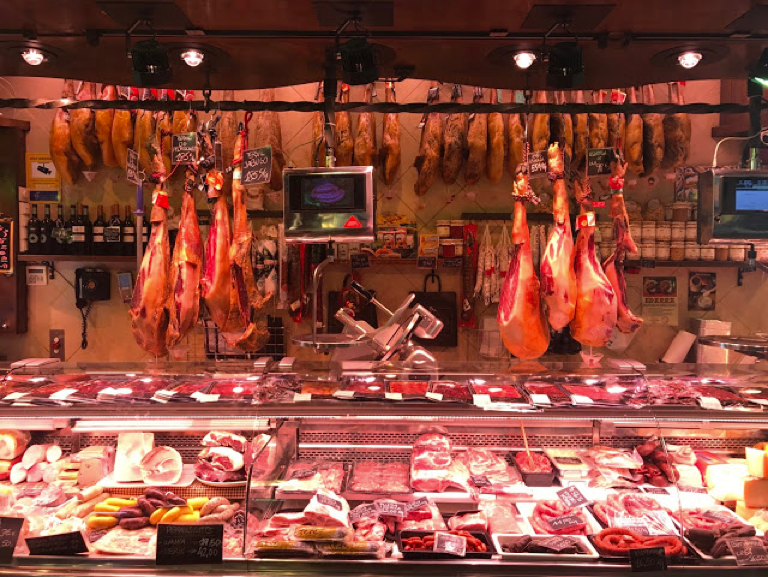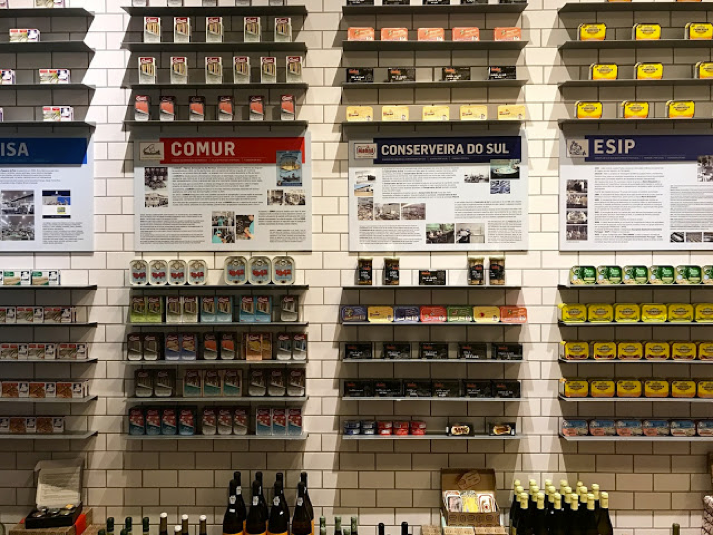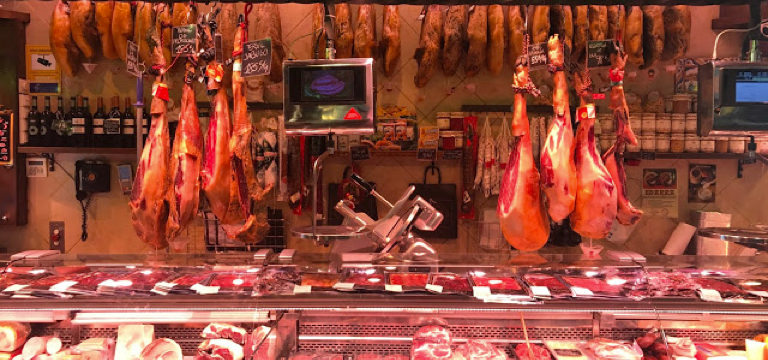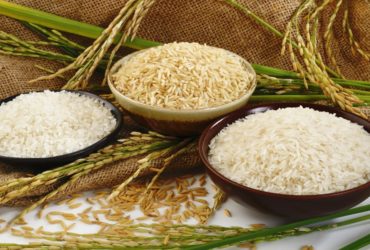BY: AMELIA CHEN
As a food scientist, there are too many delicious foods that come to mind when you say “preservation,” such as cheese or sausage or pickles, so I’m going to limit it to the three most delicious preserved foods I saw (and ate) on a recent trip to Spain and Portugal.
1. The giant legs of ham hanging in rows from every market stall.

It honestly still makes my mouth water just thinking about it. Jamon Iberico is now synonymous with Spain in my head. Described as “intensely sweet, … floral, earthy, nutty like good Parmesan, with fat so soft it melts right in your mouth,” this notoriously expensive ham comes from the Black Iberian pig, which are descendents of the Mediterranean wild boar and identified by their black hoof (pata negra) [1]. These pigs are raised on large pastures (dehesa) to encourage muscle development through their active lifestyle of running and rooting. Dehesas are also importantly dotted with oak trees, which provide firewood, cork products, shade, and most importantly, acorns for the pigs. This is what makes good (and expensive) ham great (and even more expensive) ham. Acorn-fed pigs get a special designation when being made into ham because the acorn diet produces fat high in oleic acid content and antioxidants. At around ten months, the neutered and spayed pigs are switched from their normal diet of herbs, grass, and roots and fattened up on acorns. One pig can put down an impressive ten kilos of acorns a day, nearly doubling in weight after three to four months of feeding.
Following this acorn feeding period, the pigs are sacrificed in the winter and some choice cuts are eaten right away while scraps are turned into sausages (chorizo, salchichon, morcilla). The fatty legs are skinned, packed in sea salt, dried in the cool winter air, and stored in a curing cellar. And that’s where all the magic (read: chemical reactions, including breakdown of fats and proteins) happens. The amount of fat found in this type of ham allows for a longer curing process where about half of it drips away [3]. As winter moves into spring, the meat begins to sweat, and the high salt content prevents bacterial growth. The meat dries out again during the second winter, and this sweating and drying happens two to three more times (over 2-3 years) during which complex flavors are produced and fats are broken down until the final product, a dark red and marbled meat with soft and creamy fat, is reached. During curing, the temperature and humidity are closely monitored, and the hams are rubbed down with oil to prevent insects from taking residence in the meat. Before leaving the cellar and arriving at restaurants and markets though, a final sniff test is taken to ensure all the sweet, nutty, and fermented aromas are there and well balanced [1].
For such a delicate and expensive product, you can be sure there is legislation surrounding labeling of the product. The percentage of the pigs’ Iberian ancestry must be labeled, and acorn versus corn-fed pigs are distinguished. For comparison, I bought 85 grams each of jamon iberico (corn-fed ham) and jamon iberico de bellota (acorn-fed ham) for 10 and 18 euros respectively. Only 5% of commercial Iberian pigs are both purebred and acorn-fed [1].
2. The brightly colored tins of fish arranged by cannery and history.

We may not feel the same here in the states, but I discovered sardines were a big deal in Portugal after seeing colorful ceramic, wooden, or paper sardine souvenirs in every shop. I was even more surprised to find out that there were entire stores dedicated solely to canned sardines. Loja das Conservas (House of Canned Goods) stocks over 300 types of canned fish [4]. Sardines are, of course, the most popular, but you can also find tuna, eel, mackerel and horse mackerel, mussels, and octopus. Fish preservation in Portugal dates back to the Iron Age when salting was the main method [5]. In 1853, the first commercial canneries for canning sardines in olive oil were opened, and nine years later in 1862, pasteurization was introduced, allowing more canneries to open and preserve more fish than just sardines. Can-sealing machines and other new technologies streamlined the canning process in the 1900s, and by 1983, there were over 100 fish canneries in Portugal.
To begin this process,fresh caught sardines are sorted by size so each tin of sardines is uniform. Their heads and tails are cut off, and the fish are then cleaned and packed into tins and steam cooked at 100°C. These tins are overfilled with oil or tomato sauce and pressure sealed. Pressure canning is used for low acid foods (above pH 4.6) to reach the higher temperatures needed to kill off Clostridium botulinum spores and reduce risk of botulism food poisoning. Finally the tins are cooked to sterilize and labeled [2]. The good news is you can stockpile canned fish for years! Which was exactly my intention when I brought home several cans. Not only are they delicious, but canned sardines also come with several health benefits. They are loaded with omega-3 fatty acids, vitamins, and minerals, and because the canning process breaks down the bones to make them more digestible, there is also ten times more calcium in canned fish than fresh varieties. Canned fish are frequently used in tapas dishes, where their oily, saltiness pair well with something acidic like fresh tomatoes or lemon. I was also a fan of sardines with roasted red pepper on toast.
3. The cellar of casks filled with ageing port.

Over the years since I have been of legal drinking age, I’ve been on numerous winery and brewery tours, and you can pretty much expect a lot of the same processing elements. However,there was something about standing in the middle of one of the oldest port wineries in the world in Portugal that felt extra unique. Along with sherry and madeira, port is a fortified wine, meaning distilled grape spirit, or brandy is added to the wine during the process.
Port has its origins in the hot and dry Douro Valley of Portugal. There, about thirty grape varieties are grown along steep hillsides using innovative landscaping methods. The grapes are then harvested in September and taken to the winery to be tread (crushed with people’s feet) in two stages. The first stage is called the cut, or corte, to crush the grapes and release the juice. To make sure all the grapes are completely crushed in the lagar, treading must be uniform. The second stage is called the liberty, or liberdade, where treaders can dance around the lagar freely to keep the grape skins submerged. This part is almost like a celebration with people dancing around the large troughs.

https://makeagif.com/gif/grape-stomp-lady-funny-classic-accident-NUmClh
The fermentation begins after several hours, and long wooden poles are occasionally used to punch the skins back under the surface. When half of the sugars are consumed by yeast and converted into alcohol, the skins are allowed to float to the surface, and the wine is drained out into a vat. Brandy is added at a ratio of 115 liters of spirit to 435 liters of wine, and the increased alcohol content stops yeast fermentation. The higher alcohol content allows for longer aging times in wooden casks or bottles, which transform the intense fruity flavors to the more mellow and nuanced flavors of port. Meanwhile, the color changes from deep red to light amber. Since half of the natural grape sugars still remain, port is characteristically sweet, and it is commonly served at the end of a meal as an aperitif [6].
Conclusion
Give me a platter of canned sardines and delicate slices of jamon and some port to wash it down with, and I’d call it a well rounded meal. Aside from having a taste for preserved foods, I like them for their nod to some long ago time when people necessarily had to come up with ways to stretch their food supply… instead of just because it tasted amazing. It does help that it tasted amazing, though. I like that there’s a sense of tradition preserved in every leg of ham, tin of sardines, or bottle of port.
References
[1] Falkowitz, Max. “Inside the secret world of super-premium Spanish Jamon Iberico.” March 2014. <http://www.seriouseats.com/2014/03/inside-the-secret-world-of-super-premium-spanish-jamon-iberico.html> 11 September 2017.
[2] [How It’s Made]. (2015, April 24). How It’s Made Sardines [Video File]. Retrieved from https://www.youtube.com/watch?v=doOxeHLg7Ks
[3] Jamon. “About Jamon Iberico.” 2017. <https://www.jamon.com/about-jamon-iberico.html> 11 September 2017.
[4] Lisboa Cool. “Loja das Conservas.” 2017. <http://lisboacool.com/en/shop/loja-conservas-representing-portugal-from-north-to-south> 11 September 2017.
[5] Smith, Andrea. “Conservas de Peixe: The tasty but discernible truth behind canned fish in Portugal.” Catavino. 2005. <https://catavino.net/portuguese-and-spanish-canned-fish/> 11 September 2017.
[6] Taylor’s Port. “Introduction to Port.” 2013. <http://www.taylor.pt/en/what-is-port-wine/introduction/> 11 September 2017.






Hey Amelia,
I thought this was a really fun read. It’s definitely making me excited to visit Spain/Portugal sometime, and certainly I’ll give these foods a try when I’m in the country!
– Bryan